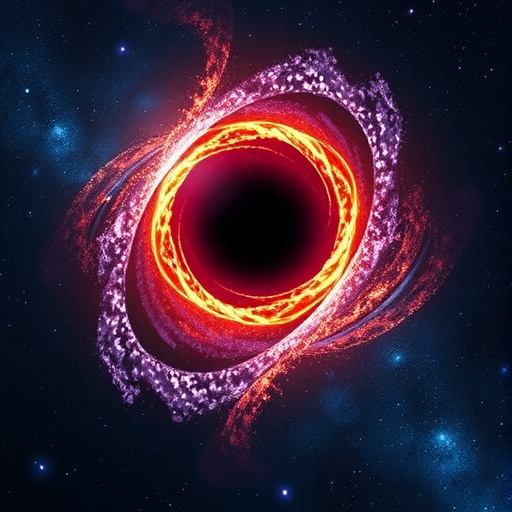In the vast tapestry of the cosmos, black holes stand as enigmatic behemoths, regions where gravity warps the fabric of space and time to its extreme. These celestial objects are more than just cosmic vacuum cleaners; they oscillate in subtle rhythms known as quasinormal modes, vibrations that ripple through spacetime itself. For decades, scientists have endeavored to decode these vibrations, as they carry vital information about a black hole’s fundamental properties such as mass, spin, and the intricate geometry of the surrounding spacetime. Recent groundbreaking research from Kyoto University reveals a pioneering mathematical framework that promises unprecedented precision in capturing these elusive signals.
Quasinormal modes are akin to the ringing of a bell, yet in the context of black holes, these “rings” are gravitational waves—disturbances propagating at the speed of light, born from titanic cosmic collisions or perturbations. When two black holes merge, the resultant structure settles into equilibrium through these damped oscillations. Detecting these waves has transformed astrophysics, providing direct evidence of black holes and testing Einstein’s theory of general relativity under extreme conditions. However, calculating the subtle frequencies and decay rates of these modes with high accuracy has long been a mathematical challenge, especially for modes that fade rapidly and are sensitive to the black hole’s complex geometry.
Addressing this challenge, a team of researchers led by Taiga Miyachi employed an advanced mathematical technique known as the exact Wentzel-Kramers-Brillouin (exact WKB) analysis. Traditionally rooted in quantum mechanics and differential equations, the exact WKB method rigorously traces wave behavior, extending the problem into the complex plane—a domain where conventional real-number approaches fall short. This exacting approach allowed the team to map the intricate structure of waves emanating from black holes with exceptional detail, illuminating features previously obscured in standard analyses.
Central to this new framework is the investigation of Stokes curves—mathematical boundaries in the complex plane where the character of wave solutions shifts dramatically. These curves delineate transitions between regions dominated by exponentially growing or decaying solutions, revealing the topology underlying black hole vibrations. While prior studies typically simplified or ignored these infinitely spiraling curves due to their complexity, the Kyoto University group incorporated them fully into their model, unlocking a richer understanding of how gravitational waves propagate near these cosmic objects.
The research elucidated that the frequency patterns of quasinormal modes are far more intricate than previously understood. The spiraling nature of Stokes curves was found to govern subtle interference and decay mechanisms in the black hole’s “ringing,” a revelation that opens the door to capturing even the most rapidly fading vibrations. This precision is paramount for matching theoretical predictions with observations made by gravitational wave observatories such as LIGO and Virgo, which strive to extract the faintest signals buried within cosmic noise.
Applying the exact WKB analysis, the researchers demonstrated a systematic way to calculate the full spectrum of vibrational frequencies, accounting for the complex interplay of waves near the event horizon and extending outwards to distant observers. Their method bridges the divide between pure mathematical theory and astrophysical reality, providing a robust computational toolkit for future studies exploring black hole dynamics across a range of scenarios.
Furthermore, this analytical advance has profound implications for gravitational wave astronomy. With more precise models, scientists can refine parameter estimation for black hole mergers, improving measurements of mass, spin, and potentially the presence of exotic physics beyond standard general relativity. This heightened sensitivity will play a critical role as detectors evolve, enabling the unraveling of the universe’s most profound mysteries through gravitational fingerprints.
Dr. Miyachi reflects on the cultural and intellectual heritage of the methodology employed: “The foundations of the exact WKB method were largely developed by Japanese mathematicians. Applying this method to physical phenomena such as black holes feels both familiar and pioneering. Our work uncovers beautiful, intricate structures that provide fresh insights into the physics of these extraordinary objects.”
Looking ahead, the team plans to extend their analysis to rotating black holes—known as Kerr black holes—which exhibit even richer dynamics due to their angular momentum. Additionally, there is potential for the exact WKB approach to influence studies of quantum gravity, exploring how classical notions of spacetime might merge with quantum principles in the extreme frontier of black holes.
This research not only advances our theoretical understanding but also enhances the interpretative framework for the observational era of gravitational wave science. As humanity’s listening devices grow ever more sensitive, decoding the “soundscapes” of black holes with the precise mathematical language now forged by this work will lead to deeper comprehension of the universe’s architecture and fundamental laws.
Ultimately, the Kyoto University team’s contribution represents a monumental step in gravitational physics, transforming abstract mathematical tools into practical instruments for exploring the cosmos. Their success demonstrates the surprising elegance hidden within the complexity of black hole quasinormal modes and exemplifies the fruitful interplay between mathematics and physics in unraveling nature’s most profound enigmas.
Subject of Research: Not applicable
Article Title: Path to an exact WKB analysis of black hole quasinormal modes
News Publication Date: 24-Jun-2025
Web References: 10.1103/1gmr-9f1g
Image Credits: KyotoU / Taiga Miyachi
Keywords
Black holes, Astrophysics, Celestial bodies, Space research, Vibration




